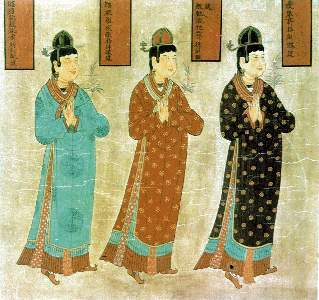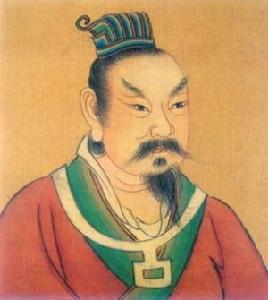|
Li Yichang
Li Yichang () (d. 909/910) was an ethnically-Dangxiang warlord of the Chinese Five Dynasties and Ten Kingdoms state Later Liang, ruling Dingnan Circuit (定難, headquartered in modern Yulin, Shaanxi) from 908 to his death in 909 or 910, as its military governor (''Jiedushi'') in ''de facto'' independence. Biography It is not known when Li Yichang was born. The traditional histories conflict on Li Yichang's relationship with his predecessor Li Sijian. The '' History of the Five Dynasties'','' History of the Five Dynasties'', vol. 132. the ''New History of the Five Dynasties'',''New History of the Five Dynasties'', vol. 40. and the ''Zizhi Tongjian''''Zizhi Tongjian'', vol. 267. all indicated that he was Li Sijian's son. However, the '' History of Song'' indicated that he was the grandson of Li Sijian's predecessor and older brother Li Sigong.'' History of Song'', vol. 485. In any case, when Li Sijian died in 908, Li Yichang claimed the title of acting military governor of ... [...More Info...] [...Related Items...] OR: [Wikipedia] [Google] [Baidu] |
Dangxiang
The Tangut people ( Tangut: , ''mjɨ nja̱'' or , ''mji dzjwo''; ; ; mn, Тангуд) were a Tibeto-Burman tribal union that founded and inhabited the Western Xia dynasty. The group initially lived under Tuyuhun authority, but later submitted to the Tang dynasty, prior to their establishment of the Western Xia. They spoke the Tangut language, which was previously believed to be one of the Qiangic languages or Yi languages that belong to the Tibeto-Burman family. Phylogenetic and historical linguistic accounts, however, reveal that Tangut belonged to the Gyalrongic languages. Language The Tangut language, otherwise known as ''Fan'', belongs to the Tibeto-Burman branch of the Sino-Tibetan language family. Like many other Sino-Tibetan languages, it is a tonal language with predominantly mono-syllabic roots, but it shares certain grammatical traits central to the Tibeto-Burman branch. It is still debated as to whether Tangut belongs to the Yi or Qiangic subdivision of ... [...More Info...] [...Related Items...] OR: [Wikipedia] [Google] [Baidu] |
Tang Dynasty People
Tang or TANG most often refers to: * Tang dynasty * Tang (drink mix) Tang or TANG may also refer to: Chinese states and dynasties * Jin (Chinese state) (11th century – 376 BC), a state during the Spring and Autumn period, called Tang (唐) before 8th century BC * Tang dynasty (唐; 618–907), a major Chinese dynasty * Later Tang (唐; 923–937), a state during the Five Dynasties and Ten Kingdoms period * Southern Tang (唐; 937–975), a state during the Five Dynasties and Ten Kingdoms period Food * Tang (drink mix), a brand name of instant fruit flavored drinks, produced by Mondelēz International * Guk, soup or stew in Korean cuisine, sometimes known as "tang" Places Europe * Tang, County Westmeath, a village in Ireland * Tang, North Yorkshire, a settlement in England Asia * Tang, Ardabil, a village in Ardabil Province, Iran * Tang, Badakhshan, a village in Afghanistan * Tang, a village in Bumthang District, Bhutan * Tang (唐镇), a town in Pudong, Shanghai, China * ... [...More Info...] [...Related Items...] OR: [Wikipedia] [Google] [Baidu] |
10th-century Deaths
1 (one, unit, unity) is a number representing a single or the only entity. 1 is also a numerical digit and represents a single unit of counting or measurement. For example, a line segment of ''unit length'' is a line segment of length 1. In conventions of sign where zero is considered neither positive nor negative, 1 is the first and smallest positive integer. It is also sometimes considered the first of the infinite sequence of natural numbers, followed by 2, although by other definitions 1 is the second natural number, following 0. The fundamental mathematical property of 1 is to be a multiplicative identity, meaning that any number multiplied by 1 equals the same number. Most if not all properties of 1 can be deduced from this. In advanced mathematics, a multiplicative identity is often denoted 1, even if it is not a number. 1 is by convention not considered a prime number; this was not universally accepted until the mid-20th century. Additionally, 1 i ... [...More Info...] [...Related Items...] OR: [Wikipedia] [Google] [Baidu] |
9th-century Births
The 9th century was a period from 801 ( DCCCI) through 900 ( CM) in accordance with the Julian calendar. The Carolingian Renaissance and the Viking raids occurred within this period. In the Middle East, the House of Wisdom was founded in Abbasid Baghdad, attracting many scholars to the city. The field of algebra was founded by the Muslim polymath al-Khwarizmi. The most famous Islamic Scholar Ahmad ibn Hanbal was tortured and imprisoned by Abbasid official Ahmad ibn Abi Du'ad during the reign of Abbasid caliph al-Mu'tasim and caliph al-Wathiq. In Southeast Asia, the height of the Mataram Kingdom happened in this century, while Burma would see the establishment of the major kingdom of Pagan. Tang China started the century with the effective rule under Emperor Xianzong and ended the century with the Huang Chao rebellions. While the Maya experienced widespread political collapse in the central Maya region, resulting in internecine warfare, the abandonment of cities, and ... [...More Info...] [...Related Items...] OR: [Wikipedia] [Google] [Baidu] |
People From Northwest China
A person ( : people) is a being that has certain capacities or attributes such as reason, morality, consciousness or self-consciousness, and being a part of a culturally established form of social relations such as kinship, ownership of property, or legal responsibility. The defining features of personhood and, consequently, what makes a person count as a person, differ widely among cultures and contexts. In addition to the question of personhood, of what makes a being count as a person to begin with, there are further questions about personal identity and self: both about what makes any particular person that particular person instead of another, and about what makes a person at one time the same person as they were or will be at another time despite any intervening changes. The plural form "people" is often used to refer to an entire nation or ethnic group (as in "a people"), and this was the original meaning of the word; it subsequently acquired its use as a plural form of p ... [...More Info...] [...Related Items...] OR: [Wikipedia] [Google] [Baidu] |
Later Liang (Five Dynasties) Jiedushi Of Dingnan Circuit
Later Liang may refer to the following states in Chinese history: * Later Liang (Sixteen Kingdoms) (後涼; 386–403), one of the Sixteen Kingdoms * Western Liang (555–587), also known as Later Liang (後梁), a state during the Southern and Northern Dynasties period * Later Liang (Five Dynasties) (後梁; 907–923), a state during the Five Dynasties and Ten Kingdoms period See also * Emperor Taizu of Later Liang (other) * Liang dynasty (other) * Western Liang (other) Western Liang may refer to the following states and territories in imperial China: * Western Liang (Sixteen Kingdoms) (西涼) (400–421), one of the Sixteen Kingdoms located in modern Western China * Western Liang (555–587) (西梁), a state ... * Southern Liang (other) {{disambiguation ... [...More Info...] [...Related Items...] OR: [Wikipedia] [Google] [Baidu] |
Li Renfu
Li Renfu (李仁福) (died March 10, 933''Zizhi Tongjian'', vol. 278.Academia Sinicabr>Chinese-Western Calendar Converter), possibly né Tuoba Renfu (拓拔仁福), formally the Prince of Guo (虢王), was an ethnic Dangxiang (Tangut) warlord during the Five Dynasties and Ten Kingdoms Period, ruling Dingnan Circuit (定難, headquartered in modern Yulin, Shaanxi) from 909 or 910 to his death in 933, as its military governor (''Jiedushi'') in ''de facto'' independence. Background Li Renfu was said to be from the same Tuoba clan as the late-Tang Dynasty warlord Li Sigong (né Tuoba Sigong), the first Dangxiang military governor of Dingnan,''Old History of the Five Dynasties'', vol. 132. and therefore was ethnically Dangxiang.See ''New Book of Tang'', vol. 221, part 1. His relationship to Li Sigong was not clear from the traditional Chinese sources—the ''Old History of the Five Dynasties'' indicated that he also took the Tang Dynasty imperial clan surname of Li when Li Sigon ... [...More Info...] [...Related Items...] OR: [Wikipedia] [Google] [Baidu] |
Zhu Quanzhong
Emperor Taizu of Later Liang (), personal name Zhu Quanzhong () (December 5, 852 – July 18, 912), né Zhu Wen (), name later changed to Zhu Huang (), nickname Zhu San (朱三, literally, "the third Zhu"), was a Chinese military general, monarch, and politician. He was a ''Jiedushi'' (military governor) and warlord who in 907 overthrew the Tang dynasty and established the Later Liang as its emperor, ushering in the era of the Five Dynasties and Ten Kingdoms. The last two Tang emperors, Emperor Zhaozong of Tang (Li Jie) and Emperor Ai of Tang (Li Zuo), who "ruled" as his puppets from 903 to 907, were both murdered by him. Zhu Wen initially served as a general under the rebel Huang Chao, but defected to the weakened Tang dynasty in 882. Taking advantage of the total chaos in the wake of Huang Chao's defeat, Zhu Wen was able to conquer parts of central China after destroying warlords such as Qin Zongquan, Shi Pu, Zhu Xuan, and Zhu Jin, although most of Shaanxi, Shanxi, and Hebei ... [...More Info...] [...Related Items...] OR: [Wikipedia] [Google] [Baidu] |
Li Sigong
Li Sigong (李思恭) (d. 886?''New Book of Tang'', vol. 221, part 1.), né Tuoba Sigong (拓拔思恭), formally the Duke of Xia (夏國公), was a Tangut warlord of the late Tang dynasty, who, for his contributions against the rebel Huang Chao, was installed as Dingnan Jiedushi (定難, headquartered in modern Yulin, Shaanxi) as its military governor (''Jiedushi''). The position was hereditary and passed down through his family, eventually becoming the fully independent Tangut state of Western Xia from the 11th to 13th centuries. Background It is not known when Tuoba Sigong was born. His family was of Tangut stock from the Pingxia () branch. Late in the ''Xiantong'' () era (861–874) of Emperor Yizong, he seized control of You Prefecture (宥州, in modern Ordos, Inner Mongolia), which had been established by the Tang imperial government to govern the Tangut, and claimed the title of prefect. Campaign against Huang Chao Around new year 881, during the reign of Emperor X ... [...More Info...] [...Related Items...] OR: [Wikipedia] [Google] [Baidu] |
History Of Song (Yuan Dynasty)
The ''History of Song'' or ''Song Shi'' () is one of the official Chinese historical works known as the '' Twenty-Four Histories'' of China that records the history of the Song dynasty (960–1279). It was commissioned in 1343 and compiled under the direction of First Minister Toqto'a and Prime Minister Alutu () during the Yuan dynasty (1271–1368) at the same time as the '' History of Liao'' and the '' History of Jin''. Running to a total of 496 chapters, the ''History of Song'' includes biographies of the Song Emperors along with contemporary records and biographical sketches of Song dynasty politicians, soldiers and philosophers. Publication process Kublai Khan endorsed a proposal by Liu Bingzhong and Wang E (, 1190–1273) for the compilation of historic records of the Song, Jin, and Liao dynasties but the compilation effort stalled for some time. In March 1343, the third year of Ukhaantu Khan, Emperor Huizong of Yuan's Zhizheng Era (), an Imperial edict ordered the c ... [...More Info...] [...Related Items...] OR: [Wikipedia] [Google] [Baidu] |



_1938.jpg)
